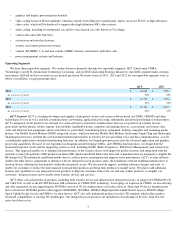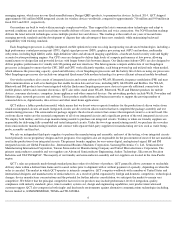Qualcomm 2014 Annual Report Download - page 20
Download and view the complete annual report
Please find page 20 of the 2014 Qualcomm annual report below. You can navigate through the pages in the report by either clicking on the pages listed below, or by using the keyword search tool below to find specific information within the annual report.
reductions in the average selling prices of our licensees’ products, unless offset by an increase in volumes, would generally decrease total
royalties payable to us, negatively impacting our licensing revenues.
Companies that promote standards that are neither CDMA- nor OFDMA-based (e.g., GSM, Wi-Fi) as well as companies that design
integrated circuits based on CDMA, OFDMA or their derivatives are generally competitors or potential competitors. Examples (some of which
are strategic partners of ours in other areas) include Broadcom, Ericsson, HiSilicon Technologies, Intel, Lantiq, Marvell Technology, Maxim
Integrated Products, MediaTek, nVidia, Realtek Semiconductor, Samsung Electronics, Spreadtrum Communications (which is controlled by
Tsinghua Unigroup), Texas Instruments and VIA Telecom. Some of these current and potential competitors have advantages over us that
include, among others: lower cost structures; better known brand names; ownership and control of manufacturing facilities and greater expertise
in manufacturing processes; motivation by our customers in certain circumstances to find alternate suppliers or chose alternative technologies;
foreign government support of other technologies or competitors; more extensive relationships with local distribution companies and original
equipment manufacturers in emerging geographic regions (such as China); and/or a more established presence in certain device markets.
Certain of our software and our suppliers’ software may contain or may be derived from “open source” software, and we have seen, and
believe we will continue to see, an increase in customers requesting that we develop products, including software associated with our integrated
circuit products, that incorporate open source software elements and operate in an open source environment, which, under certain open source
licenses, may offer accessibility to a portion of a product’s source code and may expose related intellectual property to adverse licensing
conditions. Licensing of such software may impose certain obligations on us if we were to distribute derivative works of the open source
software. For example, these obligations may require us to make source code for the derivative works available to our customers in a manner that
allows them to make such source code available to their customers, or license such derivative works under a particular type of license that is
different than what we customarily use to license our software. Developing open source products, while adequately protecting the intellectual
property rights upon which our licensing business depends, may prove burdensome and time-consuming under certain circumstances, thereby
placing us at a competitive disadvantage. Also, our use and our customers’ use of open source software may subject our products and our
customers’ products to governmental scrutiny and delays in product certification, which could cause customers to view our products as less
desirable than our competitors’ products. While we believe we have taken appropriate steps and employ adequate controls to protect our
intellectual property rights, our use of open source software presents risks that could have an adverse effect on these rights and on our business.
We derive a significant portion of our consolidated revenues from a small number of customers and licensees. If revenues derived from these
customers or licensees decrease or the timing of such revenues fluctuates, our operating results could be negatively affected.
Our QCT segment derives a significant portion of revenues from a small number of customers, and we expect this trend to continue in the
foreseeable future. Our industry is experiencing and may continue to experience an increasing concentration of device share among a few
companies contributing to this trend. In addition, one of our integrated circuit competitors is part of a conglomerate that includes one of our
largest integrated circuit customers. The loss of any one of our significant customers, a reduction in the purchases of our products by such
customers or cancelation of significant purchases from any of these customers would reduce our revenues and could harm our ability to achieve
or sustain expected operating results, and a delay of significant purchases, even if only temporary, would reduce our revenues in the period of the
delay. Further, concentration of device share among a few companies, and the corresponding purchasing power of these companies, may result
in lower prices for our products which, if not accompanied by a sufficient increase in the volume of purchases of our products, could have an
adverse effect on our revenues and margins. In addition, the timing and size of purchases by our significant customers may be impacted by the
timing of such customers’ new or next generation product introductions, over which we have little or no control, and the timing of such
introductions may cause our operating results to fluctuate. Accordingly, if current industry dynamics and concentrations continue, our QCT
segment’s revenues will continue to depend largely upon, and be impacted by, future purchases and the timing and size of any such future
purchases by these significant customers.
Further, companies that develop HLOS for devices, including leading technology companies, have entered the device market. If we fail to
effectively partner or continue partnering with these companies, or with their partners or customers, they may decide not to purchase (either
directly or through their contract manufacturers), or to reduce or discontinue their purchases of, our integrated circuit products.
In addition, there has been and continues to be litigation among certain of our customers and other industry participants, and the potential
outcomes of such litigation, including but not limited to injunctions against devices that incorporate our products and/or intellectual property or
rulings on certain patent law or patent licensing issues that create new legal precedent, could impact our business, particularly if such action
impacts one of our larger customers.
Although we have more than 260 CDMA-based licensees, our QTL segment derives a significant portion of licensing revenues from a
limited number of licensees. In the event that one or more of our significant licensees fail to meet their
15
























